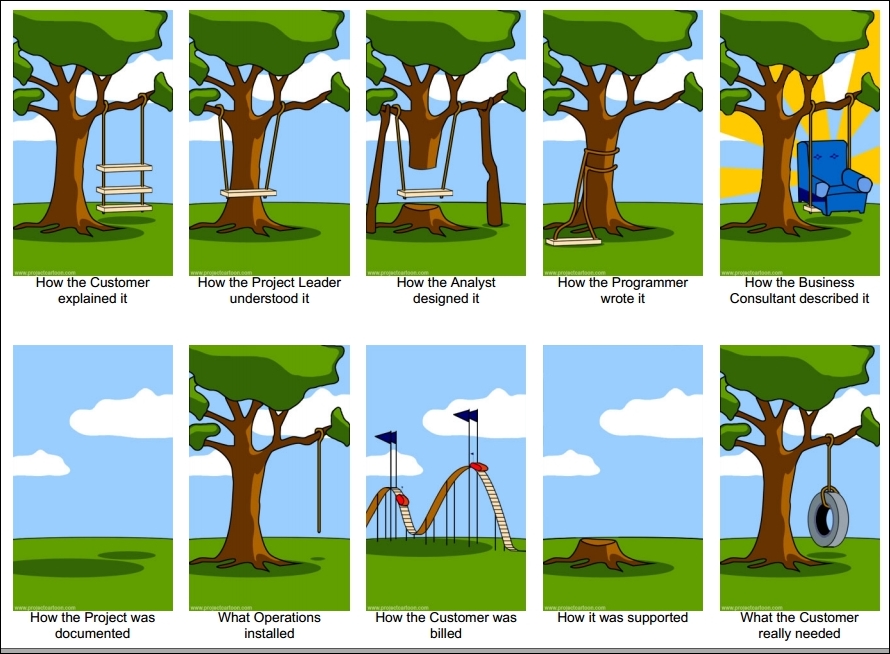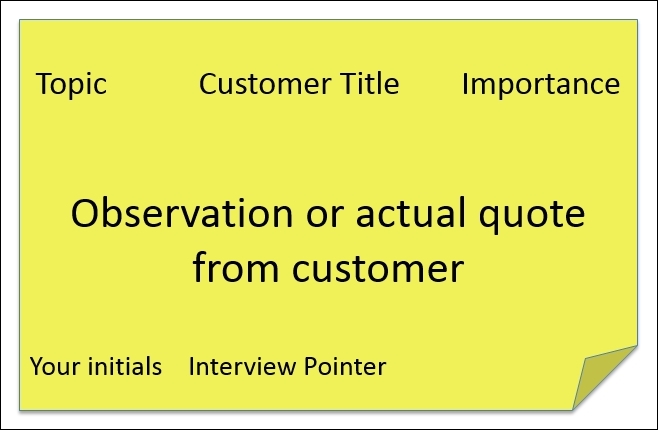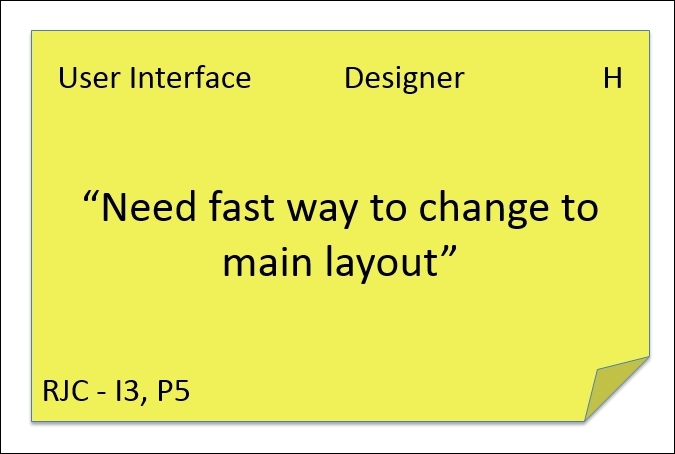"If we're building the wrong product really efficiently, it's like we're driving our car off a cliff and bragging about our awesome gas mileage." | ||
| --Eric Ries | ||
In Chapter 6, The Interview Process – The Interview, we focused on the actual interview details and structure. We talked about the various roles and responsibilities of each of the interview team members, how to select team members for the interview team, and how to get the best out of each team member. We focused on the all-important interview itself, how best to interact with the customer, and how to execute the interview to get as much meaningful data as possible from the limited time you will have with the customer. While that chapter focused on the most important phase of data collection, this chapter will delve into a number of tools and processes you can use as part of your VoC toolkit to drive new product decisions using the data you have gathered.
In today's business environment, companies cannot just assume they know what customers want—they must know for sure, which is why we undertook the actions described in the preceding chapters. Now, we are beginning to have a better understanding of what customers want, but the challenge is to then provide products and services to meet and exceed customers' desires. Business leaders have struggled for years to meet this very challenge.
You have now completed the interview process and are ready to move to the next step. You have an abundance of notes and possibly audio tapes, photos, and videos. The challenge is to make sense of all the input you and your team have received from the customers during your extensive rounds of interviews.
It is very possible you will happen upon an "aha" moment and your customer interviews will yield an almost obvious new product development that will help catapult your business to the next level. More often than not, though, you will have assimilated a great deal of customer data, observations, issues, and responses that you must now try and turn into meaningful product requirements so the organization can leverage the investment they have made into the VoC program, and take the data you have collected thus far and turn it into actionable products and services.
To do this, we will need to have a process that will help us organize and codify our observations into new products and services. Without a process, you run the risk of having only a small sub-segment of the customer's input actually making its way to the product decision step, and often it is only the most convincing or vocal of the team members who get their interviews into this step when there is no process. You need to make sure all input is considered and evaluated to ensure you are making effective product design decisions.
What we need is a process to take the customer's images, statements, and voices and transfer them into an engineering specification that can be used to create our product. If we simply share what the customer said with the development team, we will likely not get what we, or our customers, envision. You have probably seen a version of the graphic in Figure 7.1 before:

Figure 7.1
This happens when there is not a clear documented process of taking the customers' voices and images and transferring them through a process that can convert them into a meaningful, functional specification that the engineering team can build. The high-level view of the process we will use in taking the needs of the customers and turning it into a functional specification are shown here (Figure 7.2):

Figure 7.2
We will also leverage many of the tools used in six sigma, QA circles, and as part of the project management office that can also be used as part of the innovation process. While much of the work in QA revolves around doing root cause analysis of a problem, often one can see how these same philosophies of understanding a customer's problem and how to solve it are directly related.
After all the interviews are complete, and as soon as possible, it is time to bring together the various data input the teams have received and try to summarize key customer findings and identify key customer trends.
If you have followed the process laid out in this book, you should already have a good set of notes from each interview (at a minimum). The first step in our consolidation process is for everyone to consolidate all their own information from the interviews they have each attended. This is done individually and before the groups meet to discuss their findings. Everyone who has participated in the group interviews must do this without any discussion among the team members. If you had three teams with three members on each team, you would have nine sets of notes that were developed individually, separate from each other, that capture the messages each team member heard from the customers from their own individual perspective.
The first step in the consolidation process is to review your own set of notes (or the notes made by your team) and begin by highlighting key customer insights and observations that were the most relevant to you from the interviews you attended. Review your notes, transcripts, videos, and so on multiple times, and use a colored highlighter to select the key passages in your notes that best represent your customer discussions in support of your customer visit objectives. Transcribe key takeaways from videos, photos, and anything else onto a separate sheet of paper and highlight all these as well. Make sure each page of your notes is numbered (as we will need this in a later step). At the end of this step, you should have a fair number of passages highlighted.
Review your highlighted notes and remove those that are clearly duplicates or not relevant.
The next step is to transfer your highlighted key passages onto yellow sticky notes. Start by reviewing all the passages you have highlighted in the previous step and assign a point value to each passage from 1 to 5, 1 being the most important and 5 being the least important. Transfer all the passages that scored 1, 2, or 3 onto a yellow sticky note while eliminating redundant or duplicate items. Review your notes and see if there are any of the fours and fives that you think are key enough that should also be shared during the meeting with the rest of the team, and transfer them as well. When you are done, it is very likely you will have in excess of 50 yellow sticky notes and you could easily have more than 100.
Before you transfer your notes to a yellow sticky note, you must also ensure that there is a protocol for writing each of the notes on the sticky notes and that everyone follows the same process. Following is a suggested process for creating sticky notes for your VoC feedback, but you may choose to do something different. Again, what is important is that you have a consistent, repeatable process that is used by all members of your team:

Figure 7.3
When using the yellow sticky note process, as shown in Figure 7.3, it is best to use a 3x5 Post-it note. Make sure all participants write horizontally, legible only on the front in block letters, and have the sticky side on top. Follow a set protocol such as the one shown in Figure 7.3 and explained here:
- Topic: This is the topic of conversation used in your interview guide that precipitated the customer quote or observation.
- Customer title: We are looking for the customer's functional area to better understand the context of the quote or observation. We do not need the customer's name, but you and your team should agree on the "customer codes" to be used here to identify specific types of customers.
- Importance: This is an agreed-upon key signifying the level of importance or priority of the quote or observation from the customer's perspective. You and your team must decide what to put here, but a value of H=High, M=Medium, and L=Low tends to work well. If you do not use a H, M, L indication and choose something else, the key point is to make sure it is something simple and easily understood by all members of your team. Often you will be able to use the one, two, three code you used in step 1 to indicate the level of importance in this step, but not always.
- Quote or paraphrase from the customer: This is what the customer told you. What we are trying to get here is the customer's voice—something that expresses a customer's need or desired outcome. It is best to use actual customer quotes, and when doing so, use quotation marks. If you don't have direct quotes, still record what the customer said on the sticky note but do not put the observation in quotes. Whenever possible, place the observation in a positive requirements form and ask for each statement to include a verb and a noun. Try to limit the quote or observation to two lines and certainly no more than four lines.
- You're initial: This could also be your first name and last initial. We are simply looking for a way to trace the quote or observation back to you.
- Interview pointer: An agreed upon code tracing this quote back to a specific place in your notes. Often this code will include a page number and specific interview number allowing the team to trace the quote or observation to a specific location in your notes.
Figure 7.4 is an example of a sticky note that has been completely filled out as part of this exercise. As shown in this figure, try to keep the lower right-hand corner of the sticky note blank:

Figure 7.4
The quotes or paraphrases you transferred from your customer notes to your yellow sticky notes are considered customer statements. If you had the additional benefit of being able to observe how your customer uses your product or the environment where they might use your product, you probably also walked away with some distinct images in your head about the shortcomings your product has that could also be addressed by a new product or solution. This could have come about by processing the customer interview in totality, as opposed to a specific statement your customer made. Record any images you felt were pertinent and important as a result of your customer interview. Agree on a process for differentiating whether what you are recording is a customer statement or an image. As an example, you could use a different color pen for images versus statements, or perhaps a small green dot on each note that is an image.
Once you have transferred your key statements and images from your customer interview onto the yellow sticky notes, you are ready to start to prepare for the next step, where you will bring the team together to consolidate all the customer statements and images.
